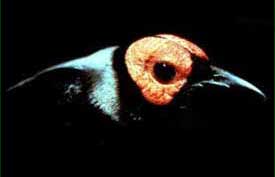Coleto
Sarcops calvus
Mynas (and their close relatives the starlings) are widely known for their ability to mimic human speech, which emerges naturally from their own noisy communication and imitation of other species of birds. Most are colored black and gray, with occasional bands of white; many have yellow eyes, and some have yellow eye-rings that contrast sharply with the black feathers. A species found only in the Philippines, the coleto (Sarcops calvus), takes this pattern to a striking extreme. Virtually the entire top of the coleto's head is bare skin of the brightest and most immodest pink, with not a feather to be seen. The sole exception is a narrow strip of black feathersthat extends from the base of the bill over the top of the crown, the presence of which seems to emphasize the absence of feathers elsewhere. The naked pink skin is entirely surrounded by the blackest of black feathers, and the eyes are almost equally dark, adding to the impact of the pink skin. On the back of the neck and upper shoulders is a mantle of silvery-white feathers; the rest of the body is a combination of contrasting gray and black. When the birds display, they erect the silvery-white mantle is erected to form a shimmering background for the skin of the head—as if the contrasting black were not enough.
Unlike the great majority of birds (and other animals and plants) that are unique to the Philippines, coletos do not require old-growth forest; they seem to prefer shrub-land and second-growth forest intermixed with mature rain forest. They do, however, require very tall dead trees in which to make holes and their nests; the nests are sometimes 35 meters above the ground. Because they so easily tolerate human disturbance, they are common and widespread, although heavily hunted to be kept as cagebirds.
Original URL: http://archive.fieldmuseum.org/vanishing_treasures/V_Coleto.htm

